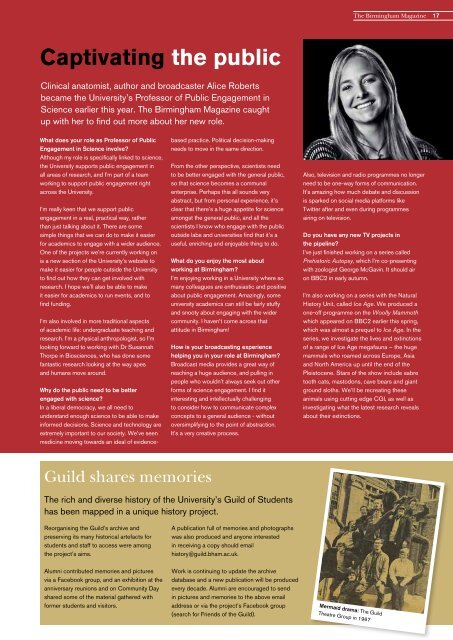BMag-2012 - University of Birmingham
BMag-2012 - University of Birmingham
BMag-2012 - University of Birmingham
You also want an ePaper? Increase the reach of your titles
YUMPU automatically turns print PDFs into web optimized ePapers that Google loves.
Captivating the public<br />
Clinical anatomist, author and broadcaster Alice Roberts<br />
became the <strong>University</strong>’s Pr<strong>of</strong>essor <strong>of</strong> Public Engagement in<br />
Science earlier this year. The <strong>Birmingham</strong> Magazine caught<br />
up with her to find out more about her new role.<br />
What does your role as Pr<strong>of</strong>essor <strong>of</strong> Public<br />
Engagement in Science involve?<br />
Although my role is specifically linked to science,<br />
the <strong>University</strong> supports public engagement in<br />
all areas <strong>of</strong> research, and I’m part <strong>of</strong> a team<br />
working to support public engagement right<br />
across the <strong>University</strong>.<br />
I’m really keen that we support public<br />
engagement in a real, practical way, rather<br />
than just talking about it. There are some<br />
simple things that we can do to make it easier<br />
for academics to engage with a wider audience.<br />
One <strong>of</strong> the projects we’re currently working on<br />
is a new section <strong>of</strong> the <strong>University</strong>’s website to<br />
make it easier for people outside the <strong>University</strong><br />
to find out how they can get involved with<br />
research. I hope we’ll also be able to make<br />
it easier for academics to run events, and to<br />
find funding.<br />
I’m also involved in more traditional aspects<br />
<strong>of</strong> academic life: undergraduate teaching and<br />
research. I’m a physical anthropologist, so I’m<br />
looking forward to working with Dr Susannah<br />
Thorpe in Biosciences, who has done some<br />
fantastic research looking at the way apes<br />
and humans move around.<br />
Why do the public need to be better<br />
engaged with science?<br />
In a liberal democracy, we all need to<br />
understand enough science to be able to make<br />
informed decisions. Science and technology are<br />
extremely important to our society. We’ve seen<br />
medicine moving towards an ideal <strong>of</strong> evidence-<br />
Guild shares memories<br />
The rich and diverse history <strong>of</strong> the <strong>University</strong>’s Guild <strong>of</strong> Students<br />
has been mapped in a unique history project.<br />
Reorganising the Guild’s archive and<br />
preserving its many historical artefacts for<br />
students and staff to access were among<br />
the project’s aims.<br />
Alumni contributed memories and pictures<br />
via a Facebook group, and an exhibition at the<br />
anniversary reunions and on Community Day<br />
shared some <strong>of</strong> the material gathered with<br />
former students and visitors.<br />
based practice. Political decision-making<br />
needs to move in the same direction.<br />
From the other perspective, scientists need<br />
to be better engaged with the general public,<br />
so that science becomes a communal<br />
enterprise. Perhaps this all sounds very<br />
abstract, but from personal experience, it’s<br />
clear that there’s a huge appetite for science<br />
amongst the general public, and all the<br />
scientists I know who engage with the public<br />
outside labs and universities find that it’s a<br />
useful, enriching and enjoyable thing to do.<br />
What do you enjoy the most about<br />
working at <strong>Birmingham</strong>?<br />
I’m enjoying working in a <strong>University</strong> where so<br />
many colleagues are enthusiastic and positive<br />
about public engagement. Amazingly, some<br />
university academics can still be fairly stuffy<br />
and snooty about engaging with the wider<br />
community. I haven’t come across that<br />
attitude in <strong>Birmingham</strong>!<br />
How is your broadcasting experience<br />
helping you in your role at <strong>Birmingham</strong>?<br />
Broadcast media provides a great way <strong>of</strong><br />
reaching a huge audience, and pulling in<br />
people who wouldn’t always seek out other<br />
forms <strong>of</strong> science engagement. I find it<br />
interesting and intellectually challenging<br />
to consider how to communicate complex<br />
concepts to a general audience - without<br />
oversimplifying to the point <strong>of</strong> abstraction.<br />
It’s a very creative process.<br />
A publication full <strong>of</strong> memories and photographs<br />
was also produced and anyone interested<br />
in receiving a copy should email<br />
history@guild.bham.ac.uk.<br />
Work is continuing to update the archive<br />
database and a new publication will be produced<br />
every decade. Alumni are encouraged to send<br />
in pictures and memories to the above email<br />
address or via the project’s Facebook group<br />
(search for Friends <strong>of</strong> the Guild).<br />
Mermaid drama: The Guild<br />
Theatre Group in 1967<br />
The <strong>Birmingham</strong> Magazine 17<br />
Also, television and radio programmes no longer<br />
need to be one-way forms <strong>of</strong> communication.<br />
It’s amazing how much debate and discussion<br />
is sparked on social media platforms like<br />
Twitter after and even during programmes<br />
airing on television.<br />
Do you have any new TV projects in<br />
the pipeline?<br />
I’ve just finished working on a series called<br />
Prehistoric Autopsy, which I’m co-presenting<br />
with zoologist George McGavin. It should air<br />
on BBC2 in early autumn.<br />
I’m also working on a series with the Natural<br />
History Unit, called Ice Age. We produced a<br />
one-<strong>of</strong>f programme on the Woolly Mammoth<br />
which appeared on BBC2 earlier this spring,<br />
which was almost a prequel to Ice Age. In the<br />
series, we investigate the lives and extinctions<br />
<strong>of</strong> a range <strong>of</strong> Ice Age megafauna – the huge<br />
mammals who roamed across Europe, Asia<br />
and North America up until the end <strong>of</strong> the<br />
Pleistocene. Stars <strong>of</strong> the show include sabre<br />
tooth cats, mastodons, cave bears and giant<br />
ground sloths. We’ll be recreating these<br />
animals using cutting edge CGI, as well as<br />
investigating what the latest research reveals<br />
about their extinctions.







![Benyamin Asadipour-Farsani [EngD Conference abstract]](https://img.yumpu.com/51622940/1/184x260/benyamin-asadipour-farsani-engd-conference-abstract.jpg?quality=85)









